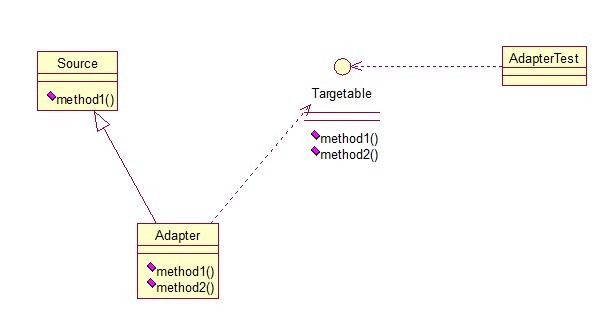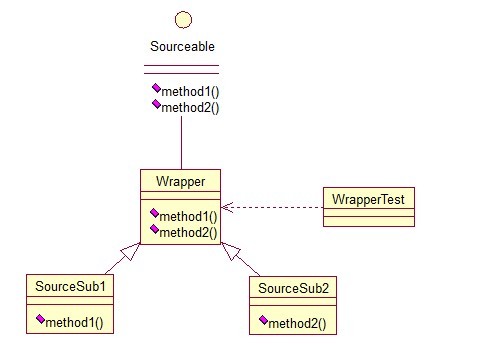6、适配器模式(Adapter Method)
来源:互联网 发布:burpsuite mac破解版 编辑:程序博客网 时间:2024/05/29 19:55
我们接着讨论设计模式,上篇文章我讲完了5种创建型模式,这章开始,我将讲下7种结构型模式:适配器模式、装饰模式、代理模式、外观模式、桥接模式、组合模式、享元模式。其中对象的适配器模式是各种模式的起源,我们看下面的图:
适配器模式将某个类的接口转换成客户端期望的另一个接口表示,目的是消除由于接口不匹配所造成的类的兼容性问题。主要分为三类:类的适配器模式、对象的适配器模式、接口的适配器模式。首先,我们来看看类的适配器模式,先看类图:
核心思想就是:有一个Source类,拥有一个方法,待适配,目标接口时Targetable,通过Adapter类,将Source的功能扩展到Targetable里,看代码:
public class Source { publicvoidmethod1() { System.out.println("this is original method!"); }}public interface Targetable { /* 与原类中的方法相同 */ public void method1(); /* 新类的方法 */ publicvoidmethod2(); }public class Adapter extendsSourceimplementsTargetable { @Override publicvoidmethod2() { System.out.println("this is the targetable method!"); }}Adapter类继承Source类,实现Targetable接口,下面是测试类:
public class AdapterTest { publicstaticvoid main(String[] args) { Targetable target =newAdapter(); target.method1(); target.method2(); }}输出:
this is original method!
this is the targetable method!
这样Targetable接口的实现类就具有了Source类的功能。
对象的适配器模式
基本思路和类的适配器模式相同,只是将Adapter类作修改,这次不继承Source类,而是持有Source类的实例,以达到解决兼容性的问题。看图:
只需要修改Adapter类的源码即可:
public class Wrapper implementsTargetable { privateSource source; publicWrapper(Source source){ super(); this.source = source; } @Override publicvoidmethod2() { System.out.println("this is the targetable method!"); } @Override publicvoidmethod1() { source.method1(); }} 测试类:
public class AdapterTest { publicstaticvoid main(String[] args) { Source source =newSource(); Targetable target =newWrapper(source); target.method1(); target.method2(); }} 输出与第一种一样,只是适配的方法不同而已。
第三种适配器模式是接口的适配器模式,接口的适配器是这样的:有时我们写的一个接口中有多个抽象方法,当我们写该接口的实现类时,必须实现该接口的所有方法,这明显有时比较浪费,因为并不是所有的方法都是我们需要的,有时只需要某一些,此处为了解决这个问题,我们引入了接口的适配器模式,借助于一个抽象类,该抽象类实现了该接口,实现了所有的方法,而我们不和原始的接口打交道,只和该抽象类取得联系,所以我们写一个类,继承该抽象类,重写我们需要的方法就行。看一下类图:
这个很好理解,在实际开发中,我们也常会遇到这种接口中定义了太多的方法,以致于有时我们在一些实现类中并不是都需要。看代码:
public interface Sourceable { publicvoidmethod1(); publicvoidmethod2(); }抽象类Wrapper2:
public abstract class Wrapper2 implements Sourceable{ publicvoidmethod1(){} publicvoidmethod2(){} } public class SourceSub1 extendsWrapper2 { publicvoidmethod1(){ System.out.println("the sourceable interface's first Sub1!"); }} public class SourceSub2 extendsWrapper2 { publicvoidmethod2(){ System.out.println("the sourceable interface's second Sub2!"); }} public class WrapperTest { publicstaticvoid main(String[] args) { Sourceable source1 =newSourceSub1(); Sourceable source2 =newSourceSub2(); source1.method1(); source1.method2(); source2.method1(); source2.method2(); }} 测试输出:
the sourceable interface's first Sub1!
the sourceable interface's second Sub2!
达到了我们的效果!
讲了这么多,总结一下三种适配器模式的应用场景:
类的适配器模式:当希望将一个类转换成满足另一个新接口的类时,可以使用类的适配器模式,创建一个新类,继承原有的类,实现新的接口即可。
对象的适配器模式:当希望将一个对象转换成满足另一个新接口的对象时,可以创建一个Wrapper类,持有原类的一个实例,在Wrapper类的方法中,调用实例的方法就行。
接口的适配器模式:当不希望实现一个接口中所有的方法时,可以创建一个抽象类Wrapper,实现所有方法,我们写别的类的时候,继承抽象类即可。
- 6、适配器模式(Adapter Method)
- 6 适配器模式(Adapter)
- 6、适配器模式(Adapter)
- 6、适配器模式(Adapter)
- 设计模式6 - 适配器模式Adapter
- 设计模式(6) - Adapter适配器模式
- 设计模式(6)-适配器模式(Adapter)
- Adapter模式 适配器模式
- 抽象模式,适配器模式(Adapter),模板方法模式(Template method)
- 设计模式之6 - 适配器Adapter
- 适配器模式(Adapter)
- 适配器模式(Adapter)
- 适配器(Adapter)模式
- 适配器模式(Adapter Pattern)
- ADAPTER(适配器)模式
- 适配器模式(adapter)
- Adapter适配器模式
- 适配器(Adapter)模式
- Deep Learning
- 5、原型模式(Prototype)
- Python解释器
- python调用shell的方法
- Dijkstra算法-最短路径-邻接矩阵表示
- 6、适配器模式(Adapter Method)
- 7、装饰模式(Decorator)
- 8、代理模式(Proxy)
- myeclipse web project如何导入jar包
- 【笔记】利用ajax返回Html代替iframe,实现局部更新
- 9、外观模式(Facade)
- AAC规格(LC,HE,HEv2)及性能对比
- 使用baidu的api完成汉译英功能
- 10、桥接模式(Bridge)


